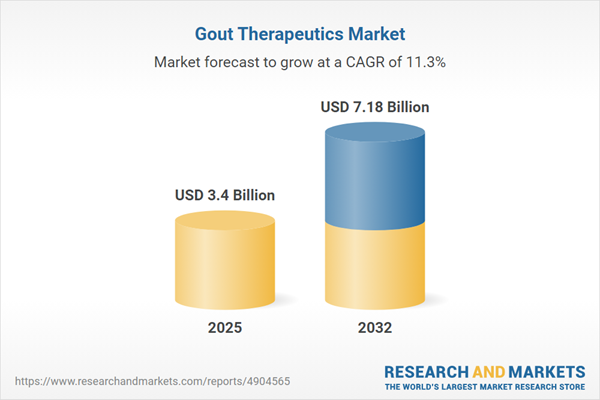Speak directly to the analyst to clarify any post sales queries you may have.
The gout therapeutics market is evolving rapidly as targeted innovation, patient-focused treatment approaches, and strategic regional shifts redefine the standards of care for this chronic inflammatory condition.
Market Snapshot: Gout Therapeutics Market Growth and Opportunities
The Gout Therapeutics Market grew from USD 3.05 billion in 2024 to USD 3.40 billion in 2025. It is expected to continue expanding at a CAGR of 11.27%, reaching USD 7.18 billion by 2032.
This trajectory is fueled by the convergence of advanced biologics, new delivery technologies, and evolving regulatory frameworks across global regions. Demand is shaped by the need for both acute flare management and sustainable long-term urate reduction, positioning the market for robust and diversified growth.Scope & Segmentation: Diverse Treatment Hierarchies and Global Footprint
- Route of Administration: Injectable (intravenous, subcutaneous), and oral modalities, each with specific benefits in speed, patient adherence, and chronic management.
- Therapy Lines: First line includes nonsteroidal anti-inflammatory drugs (ibuprofen, indomethacin, naproxen) and xanthine oxidase inhibitors (allopurinol, febuxostat); second line features colchicine and uricosuric agents (benzbromarone, lesinurad, probenecid); third line encompasses corticosteroids (methylprednisolone, prednisone) and uricase agents (pegloticase, rasburicase).
- Drug Classes: Anti-inflammatory agents, corticosteroids, uricase agents, uricosuric agents, and xanthine oxidase inhibitors (including topiroxostat).
- Distribution Channels: Hospital pharmacy (inpatient, outpatient), online pharmacy, retail pharmacy contribute to overall market accessibility and patient engagement strategies.
- Regional Coverage: Americas (North America: United States, Canada, Mexico; Latin America: Brazil, Argentina, Chile, Colombia, Peru), Europe, Middle East & Africa (Europe: United Kingdom, Germany, France, Russia, Italy, Spain, Netherlands, Sweden, Poland, Switzerland; Middle East: United Arab Emirates, Saudi Arabia, Qatar, Turkey, Israel; Africa: South Africa, Nigeria, Egypt, Kenya), Asia-Pacific (China, India, Japan, Australia, South Korea, Indonesia, Thailand, Malaysia, Singapore, Taiwan).
- Company Developments: Leading players include Takeda Pharmaceutical Company Limited, Horizon Therapeutics plc, AstraZeneca plc, Teva Pharmaceutical Industries Ltd., Viatris, Inc., Sandoz International GmbH, Sun Pharmaceutical Industries Ltd., Dr. Reddy’s Laboratories Ltd., Amneal Pharmaceuticals, Inc., and Lupin Limited.
Key Takeaways: Strategic Insights Shaping the Gout Therapeutics Market
- Biopharmaceutical companies are investing in novel molecular targets and engineering advances to support safer, more effective treatment for complex patient needs.
- The integration of digital health platforms and personalized dosing innovations enhances adherence and long-term patient outcomes.
- Varied delivery technologies, such as sustained-release oral formulations and autoinjectors, are improving convenience and addressing adherence fatigue.
- Regulatory environments are evolving, with adaptive approval pathways enabling faster market entry for biologics and rare disease modalities.
- Collaboration between industry leaders and academic research centers accelerates development timelines and expands therapy access across regions.
Tariff Impact: Navigating US Trade Policy Disruptions
New United States tariff measures imposed in 2025 have introduced supply chain complexities for gout therapeutics. These policies challenge manufacturers to optimize sourcing and regional production while ensuring inventory resilience against cost inflation. Tariffs are also influencing decisions on clinical program locations and investments in diversified supplier networks, further linking supply chain agility to long-term innovation strategies.
Methodology & Data Sources
This analysis is grounded in a systematic review of peer-reviewed journals, clinical trial databases, and regulatory filings. Qualitative expert interviews supplemented the secondary research, offering deeper insight into patient needs and evolving payer perspectives. All data were triangulated across proprietary sources and validated expert inputs to deliver an objective and actionable perspective on the gout therapeutics landscape.
Why This Report Matters: Empowering Senior Decision-Makers
- Gain a comprehensive understanding of future-ready treatment advances, key market inflection points, and evolving payer dynamics to inform strategic investments.
- Benchmark organizational strategies against regional and therapy-specific trends, while evaluating competitive positioning among global industry leaders.
- Assess tariff and regulatory risks with actionable frameworks to ensure resilient supply chains and sustained product life cycle success.
Conclusion
Senior stakeholders benefit from targeted insights that clarify the market’s complexity, future outlook, and key drivers of sustained growth. This report supports confident, evidence-based decisions in an increasingly competitive gout therapeutics environment.
Additional Product Information:
- Purchase of this report includes 1 year online access with quarterly updates.
- This report can be updated on request. Please contact our Customer Experience team using the Ask a Question widget on our website.
Table of Contents
3. Executive Summary
4. Market Overview
7. Cumulative Impact of Artificial Intelligence 2025
Companies Mentioned
The companies profiled in this Gout Therapeutics market report include:- Takeda Pharmaceutical Company Limited
- Horizon Therapeutics plc
- AstraZeneca plc
- Teva Pharmaceutical Industries Ltd.
- Viatris, Inc.
- Sandoz International GmbH
- Sun Pharmaceutical Industries Ltd.
- Dr. Reddy’s Laboratories Ltd.
- Amneal Pharmaceuticals, Inc.
- Lupin Limited
Table Information
| Report Attribute | Details |
|---|---|
| No. of Pages | 193 |
| Published | October 2025 |
| Forecast Period | 2025 - 2032 |
| Estimated Market Value ( USD | $ 3.4 Billion |
| Forecasted Market Value ( USD | $ 7.18 Billion |
| Compound Annual Growth Rate | 11.2% |
| Regions Covered | Global |
| No. of Companies Mentioned | 11 |









